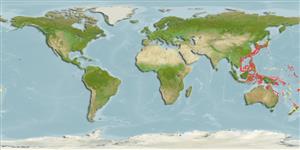Environment: milieu / climate zone / depth range / distribution range
Ecologia
marino demersale; distribuzione batimetrica 110 - 152 m (Ref. 41422). Tropical
West Pacific: southern Japan to Hong Kong, Also from Australia, Taiwan, China and Korea. A new record for Indonesia (Ref. 5978).
Size / Peso / Age
Maturity: Lm ? range ? - ? cm
Max length : 22.0 cm SL maschio/sesso non determinato; (Ref. 48635)
Spine dorsali (totale): 8; Raggi dorsali molli (totale): 10; Spine anali 3; Raggi anali molli: 8; Vertebre: 24. Parietal crests in males broad and short, not greatly elongated when compared with E. falcata. Dorsal fin rays 9.5-10.5; anal 7.5 (Ref. 41422). Adults develop a curious bony protrusion on top of the head (Ref. 48635).
Found in the sublittoral zone (Ref. 11230). Also seen in areas of cool upwelling on fine sand and mud bottoms (Ref 90102).
Life cycle and mating behavior
Maturità | Riproduzione | Deposizione | Uova | Fecundity | Larve
Masuda, H., K. Amaoka, C. Araga, T. Uyeno and T. Yoshino, 1984. The fishes of the Japanese Archipelago. Vol. 1. Tokai University Press, Tokyo, Japan. 437 p. (text). (Ref. 559)
IUCN Red List Status (Ref. 130435)
Threat to humans
Harmless
Human uses
Informazioni ulteriori
Nomi ComuniSinonimiMetabolismoPredatoriEcotossicologiaRiproduzioneMaturitàDeposizioneSpawning aggregationFecundityUovaEgg development
BibliografiaAcquacolturaProfilo di acquacolturaVarietàGeneticaElectrophoresesEreditarietàMalattieElaborazioneNutrientsMass conversion
CollaboratoriImmaginiStamps, Coins Misc.SuoniCiguateraVelocitàModalità di nuotoArea branchialeOtolithsCervelliVista
Strumenti
Special reports
Download XML
Fonti Internet
Estimates based on models
Preferred temperature (Ref.
123201): 14.5 - 23.7, mean 19.6 °C (based on 61 cells).
Phylogenetic diversity index (Ref.
82804): PD
50 = 0.6250 [Uniqueness, from 0.5 = low to 2.0 = high].
Bayesian length-weight: a=0.01023 (0.00444 - 0.02358), b=3.01 (2.82 - 3.20), in cm total length, based on LWR estimates for this (Sub)family-body shape (Ref.
93245).
Trophic level (Ref.
69278): 3.9 ±0.7 se; based on size and trophs of closest relatives
Resilienza (Ref.
120179): Medio, tempo minimo di raddoppiamento della popolazione 1.4 - 4.4 anni (Preliminary K or Fecundity.).
Fishing Vulnerability (Ref.
59153): Low vulnerability (17 of 100).
